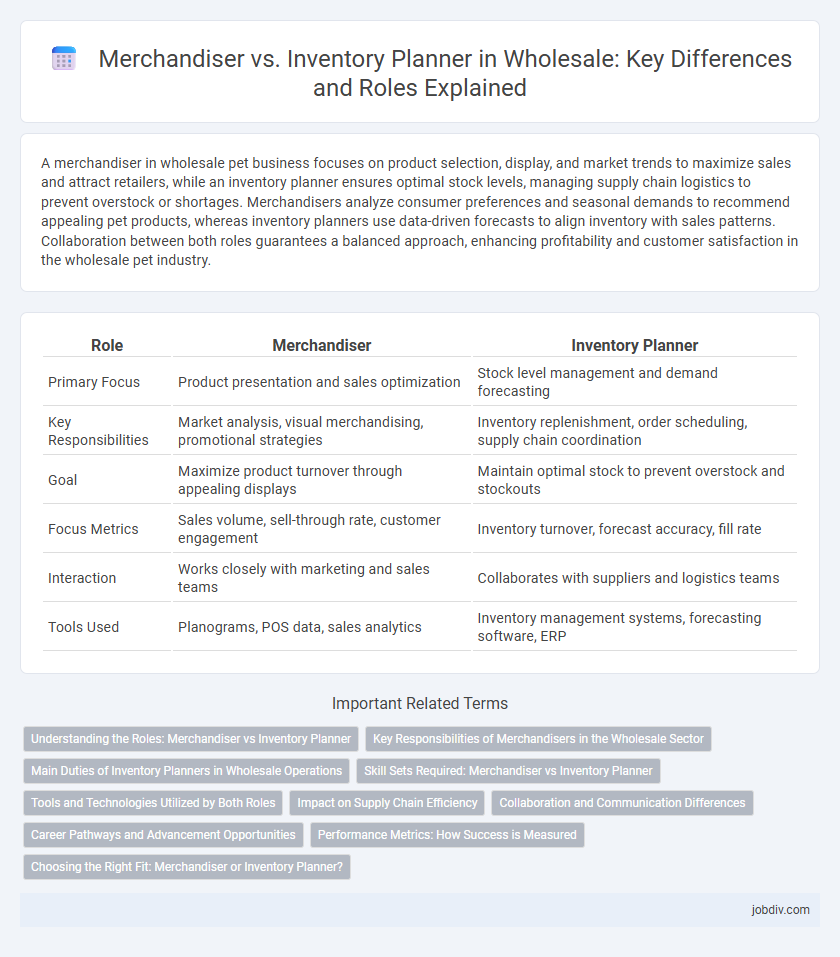A merchandiser in wholesale pet business focuses on product selection, display, and market trends to maximize sales and attract retailers, while an inventory planner ensures optimal stock levels, managing supply chain logistics to prevent overstock or shortages. Merchandisers analyze consumer preferences and seasonal demands to recommend appealing pet products, whereas inventory planners use data-driven forecasts to align inventory with sales patterns. Collaboration between both roles guarantees a balanced approach, enhancing profitability and customer satisfaction in the wholesale pet industry.
Table of Comparison
| Role | Merchandiser | Inventory Planner |
|---|---|---|
| Primary Focus | Product presentation and sales optimization | Stock level management and demand forecasting |
| Key Responsibilities | Market analysis, visual merchandising, promotional strategies | Inventory replenishment, order scheduling, supply chain coordination |
| Goal | Maximize product turnover through appealing displays | Maintain optimal stock to prevent overstock and stockouts |
| Focus Metrics | Sales volume, sell-through rate, customer engagement | Inventory turnover, forecast accuracy, fill rate |
| Interaction | Works closely with marketing and sales teams | Collaborates with suppliers and logistics teams |
| Tools Used | Planograms, POS data, sales analytics | Inventory management systems, forecasting software, ERP |
Understanding the Roles: Merchandiser vs Inventory Planner
A merchandiser analyzes market trends and consumer behavior to select and promote products that maximize sales and optimize shelf placement. An inventory planner focuses on forecasting demand and managing stock levels to prevent overstock or stockouts, ensuring the right products are available at the right time. Both roles are critical in wholesale to balance product availability with customer demand and profitability.
Key Responsibilities of Merchandisers in the Wholesale Sector
Merchandisers in the wholesale sector are responsible for analyzing market trends and customer demand to optimize product assortment and maximize sales. They collaborate closely with suppliers and sales teams to ensure timely procurement and effective presentation of goods. Their role includes monitoring stock levels, pricing strategies, and promotional activities to drive wholesale revenue growth.
Main Duties of Inventory Planners in Wholesale Operations
Inventory planners in wholesale operations are responsible for forecasting demand, managing stock levels, and coordinating reorder schedules to prevent stockouts or excess inventory. They analyze sales trends and historical data to optimize inventory turnover, ensuring efficient capital use and meeting customer demand. Their role directly impacts supply chain efficiency, cost control, and overall profitability in wholesale distribution.
Skill Sets Required: Merchandiser vs Inventory Planner
Merchandisers require strong market analysis skills, trend forecasting, and vendor negotiation abilities to drive product assortment and pricing strategies. Inventory planners must excel in demand forecasting, stock optimization, and data analytics to maintain optimal inventory levels and prevent stockouts or overstock situations. Both roles demand proficiency in supply chain management software and collaboration skills to align merchandise availability with sales objectives.
Tools and Technologies Utilized by Both Roles
Merchandisers utilize visual merchandising software and retail analytics tools to optimize product placement and enhance customer engagement in wholesale environments. Inventory planners rely heavily on demand forecasting software, ERP systems, and automated replenishment technologies to maintain optimal stock levels and reduce holding costs. Both roles integrate data analytics platforms to align inventory strategies with market trends and sales performance.
Impact on Supply Chain Efficiency
Merchandisers drive supply chain efficiency by forecasting demand and selecting products that meet market trends, directly influencing inventory turnover rates and reducing stockouts. Inventory planners optimize stock levels through precise replenishment strategies, minimizing carrying costs and preventing excess inventory. Together, their roles enhance overall supply chain responsiveness, streamline order fulfillment, and improve customer satisfaction in wholesale operations.
Collaboration and Communication Differences
Merchandisers focus on selecting and promoting products based on market trends and customer preferences, requiring frequent communication with sales teams and suppliers to ensure alignment on merchandise strategies. Inventory planners concentrate on forecasting demand and managing stock levels, collaborating closely with logistics and warehouse teams to optimize inventory turnover and minimize stockouts. Effective collaboration between merchandisers and inventory planners hinges on clear, consistent communication channels to balance product availability with market demand, driving overall wholesale efficiency.
Career Pathways and Advancement Opportunities
Merchandisers in wholesale focus on product selection, pricing strategies, and promotional activities, developing skills in market analysis and supplier negotiation, which can lead to roles like Senior Merchandiser or Category Manager. Inventory Planners specialize in demand forecasting, stock optimization, and replenishment processes, gaining expertise that advances toward positions such as Inventory Manager or Supply Chain Analyst. Career advancement for both pathways depends on proficiency in data analysis, cross-functional collaboration, and understanding of market trends within the wholesale sector.
Performance Metrics: How Success is Measured
Merchandiser performance is primarily measured by sales growth, product placement effectiveness, and promotional campaign impact, reflecting their ability to drive customer demand and maximize revenue. Inventory planners are evaluated based on inventory turnover rates, stock accuracy, and service level targets, ensuring optimal stock levels and minimizing carrying costs. Both roles rely on key performance indicators (KPIs) such as forecast accuracy and order fulfillment rates to align supply with market demand efficiently.
Choosing the Right Fit: Merchandiser or Inventory Planner?
Merchandisers focus on product presentation, pricing strategies, and seasonal trends to maximize sales and enhance customer experience in wholesale markets. Inventory planners concentrate on forecasting demand, managing stock levels, and optimizing reorder points to ensure product availability while minimizing carrying costs. Choosing the right fit depends on whether the priority is driving sales through merchandise appeal or maintaining efficient stock control to meet market demand.
Merchandiser vs Inventory Planner Infographic

 jobdiv.com
jobdiv.com